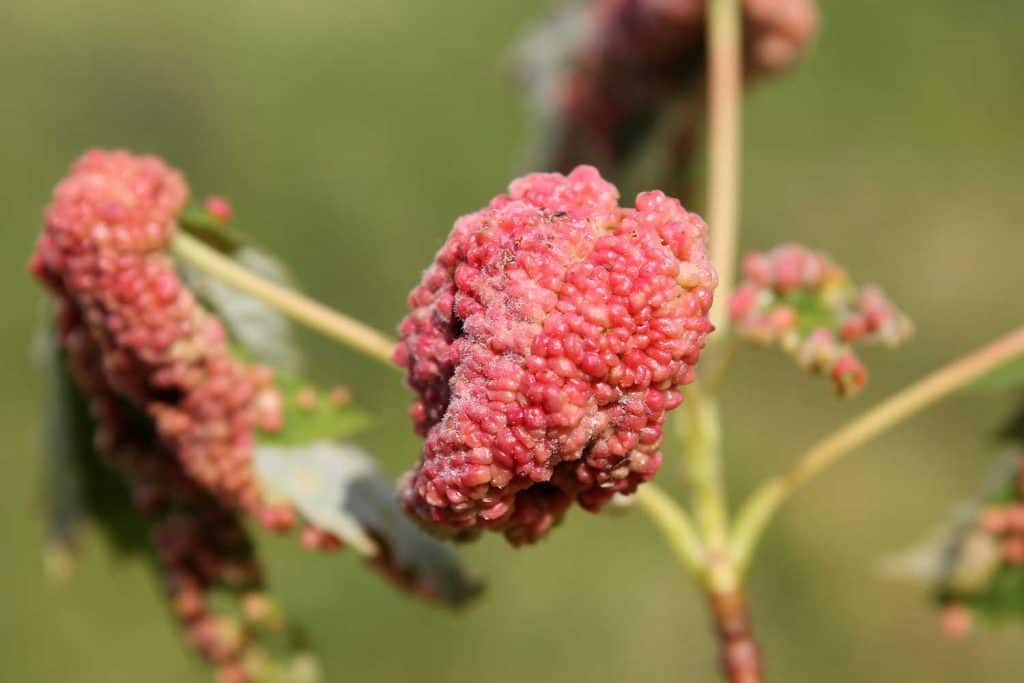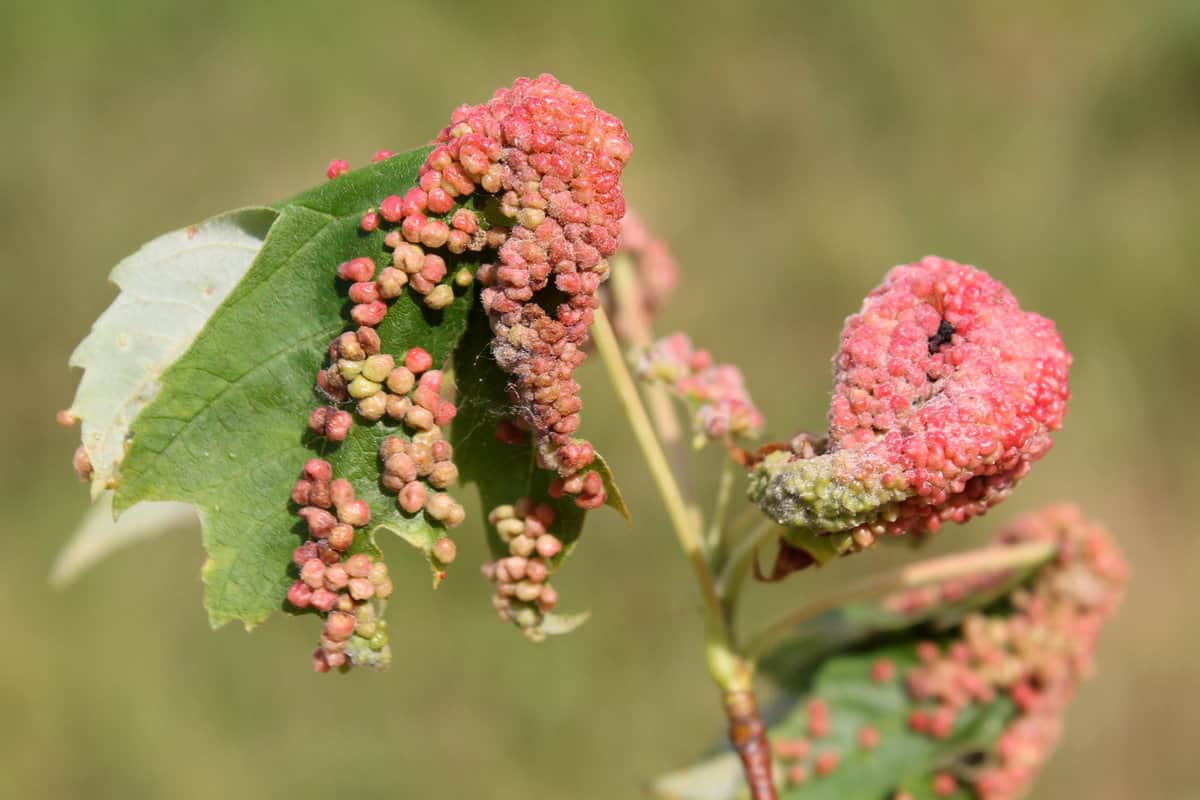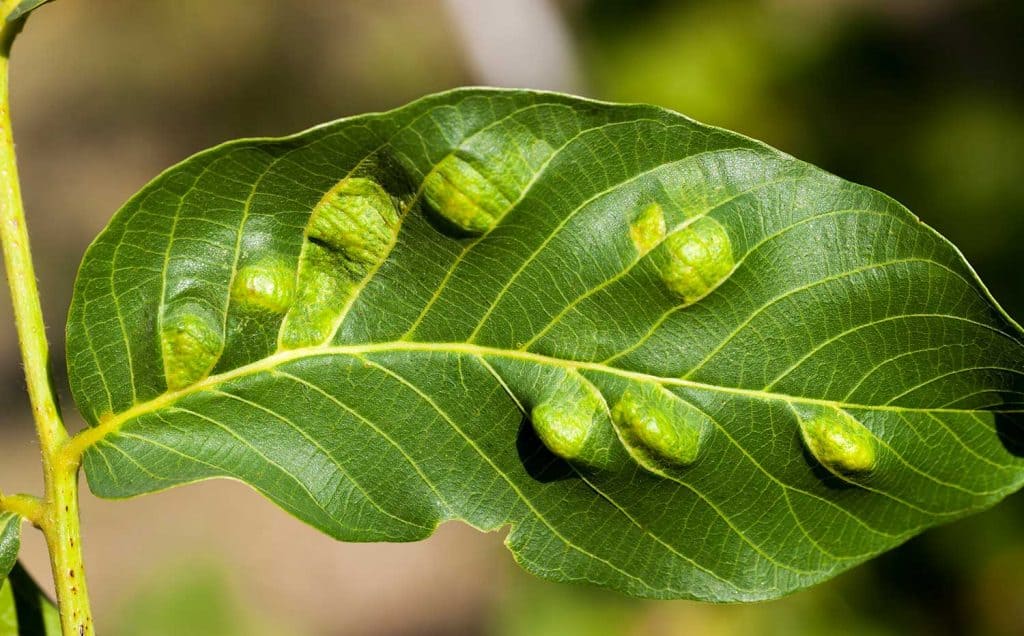Gall mites are microscopic cigar-shaped mites that feed on a variety of plants, sap, and fruit. If your maple tree or fuchsia has a gall mite infestation, it's best to tend to it as soon as possible. But what is the best way to eradicate these mites? We've researched how to prevent and eradicate gall mites on these trees, and in this post, we will share our findings with you.
Here are the most effective measures to exterminate gall mites:
- Cut off infected leaves
- Place a natural gall mite predator on the tree
- Use a dormant oil
- Use a diazinon-based pesticide
- Apply liquid lime sulfur
Sometimes a gall mite infestation won't require any treatment at all, it might not be severe enough to harm the tree. In other cases, it's best to remedy the infestation because it can cause the tree to become deformed and display unsightly cosmetic damage. Continue reading to learn how to get rid of these mites quickly and effectively.
![How To Get Rid Of Gall Mites [Inc. On Maple Trees And On Fuchsia]](https://gardentabs.com/wp-content/uploads/2021/05/How-To-Get-Rid-Of-Gall-Mites-Inc.-On-Maple-Trees-And-On-Fuchsia.png)
How To Get Rid Of Gall Mites On Maple Trees And On Fuchsia
It's best to inspect the leaves, branches, and bark of the plant to decide which method will work best for getting rid of the gall mites. In the case of maple trees, there are insecticides that you can spray on the bark. Let's discuss them in more detail.

Cut off infected leaves
The quickest way to get rid of gall mites is to simply cut off the infected leaves and branches to minimize their populations. You can use a pair of pruning shears or a utility knife to do this. This method is suited for both maples and fuchsia trees. It's especially effective for the fuchsia tree, as it's smaller and the leaves and branches are easier to reach. It's also much safer than applying insecticides.
To remove the mites from the plant, start by cutting off any infected branch at least two nodes below the infected area. Ensure that the mites aren't scattered onto the surrounding plants as they can easily infest them. Next, burn the plant clippings or seal them in a trash bag and leave them in the sun for a couple of days before completely discarding them. This will keep the mites from finding their way back to your garden or lawn.


Find pruning shears on Amazon.
Place a natural gall mite predator on the tree
You can also release a predator to eradicate the gall mites naturally. The main gall mite predators to consider are ladybugs and lace wigs. Your local gardening store may have these insects available, or you may be able to purchase them online as well. This method is perfect for both maples and fuchsia trees.

Use a dormant oil
Dormant oils can also be applied to the maple tree's bark to get the gall mites to go back into the bark. It's best to apply the spray when the temperatures are over 40 degrees Fahrenheit so that it will not freeze on the tree's bark. This method is best used for maple trees but can also be used on the fuchsia plant to eradicate mites.
When applying the spray, be sure to apply it generously to the entire trunk and cover all sides for a thorough treatment. If applying the spray to the fuchsia tree, be sure to thoroughly cover the leaves, flowers, and branches of the plant.


Take a look at this dormant oil on Amazon.
Use a diazinon-based pesticide
Applying an insecticide can kill the gall mites on the spot. Keep in mind that applying the insecticide to your fuchsia tree can be hard on the tree, depending on the age of the plant. If using this method on a maple, completely spray all sides of the bark for full treatment. Also, be sure to follow the manufacturer's instructions on the can and watch the tree closely afterward for further infestation.
Keep in mind that hummingbirds and bees both carry the gall mite, and they may lay eggs on the tree's bark. The best time to apply the insecticide is after spring growth begins.


Learn more about this insecticide on Amazon.
Apply liquid lime sulfur
You can also use liquid lime sulfur to spray down the maple tree. The best time to apply this is during the dormant season. To apply the sulfur, spray the bark down completely during the spring or summer months, make sure that the temperature is above 40 degrees Fahrenheit to prevent the solution from freezing on the bark. For the next couple of weeks, keep an eye on the tree to check for signs of re-infestation.
What do gall mites do?
Gall mites suck sap from trees and plants. During their feeding process, they secrete chemicals into plants that affect their parenchyma cells, which in turn causes them to produce a gall.
How do you treat gall mites?
Oftentimes, you'll find that gall mite infestations will go away on their own once the mites go back into the tree. In the case of the fuchsia gall mite, the best way to rid of the infestation is to simply cut the infected leaves and branches from the plant. You can also apply insecticidal soap or oil to the entire plant once it's prone to get rid of any remaining mites.
When applying the soap, it's best to continue the application every 7 to 10 days to completely eradicate the mites. If the infestation is especially invasive, you will want to prune the plant thoroughly during the winter and then spray it with insecticidal soap or dormant oil right before the spring before it develops new growths.
How do you get rid of Maple gall mites?

You can get rid of maple gall mites by spraying the tree down with insecticide, dormant spray, or by applying liquid lime sulfur to the tree. If the infestation is especially invasive, you may also want to prune down the tree.
If you plan to prune the maple trees, it's best to do it in early spring using a pair of loppers or pruning shears. When turning the treatment, be sure to remove all infected twigs, branches, and leaves. This will usually minimize the adult population of gall mites.
Afterward, be sure to place the infected stems into trash bags to prevent them from reinfecting the tree. It's best to use a pressure sprayer when applying the insecticide, as it can cover the bark quickly and effectively. Be sure to discard your clothing in a trash bag immediately after spraying the tree.
Before pruning the infected leaves, it's always best to wear protective gear, especially if you're going to spray the bark with insecticide or dormant spray. Your gear should include work gloves, safety goggles, a ventilator mask on as well as long sleeve clothing. It's also helpful to place a tarp around the ground to protect any neighboring plants, flowers, or grass from being affected by the insecticide or gall mites.


Check out his protective suit on Amazon.
Will gall mites kill my maple tree?
It's unlikely that mites will kill your maple tree. For the most part, they only inflict cosmetic damage and do not pose serious harm to the host plant that they infest. If you are concerned with the mites affecting the look of your tree, it's best to prune the tree down or apply an insecticide to help keep them at bay.
Maple and Oak trees are very susceptible to gall mites because of their sap and thick bark, which gall mites love to hide beneath. Though the galls can cover a large portion of the tree, they only reach up to an eighth of an inch in width and can typically be scraped off once the infestation is eradicated.
What does fuchsia gall mite look like?
Gall mites are reddish, microscopic insects that have long oval-shaped bodies. You typically won't see the mites themselves, but more so the wounds and scars that they cause to your plants and trees, called galls.
How do you get rid of fuchsia gall mites?

To get rid of mites on a fuchsia, prune any infected parts of the tree before early spring. Make sure that you prune each branch two nodes past the damage to ensure that you cut off the entire infected area. You'll also want to remove any flower buds, loose bark, and leaves that may be infected as well. If needed, use a disposable toothbrush to help remove any loose bark.
You can also spray the fuchsia tree with insecticide, dormant spray, or liquid slime oils as well. After removing the infected parts and spraying the tree, be sure to properly dispose of or sterilize everything to avoid reinfection. This includes sterilizing any pruning shears, knives, or other equipment used to prune the tree.
Do gall mites bite humans?
Yes, gal mites can bite humans when they're looking for food. They don't target humans specifically, however, so if they make contact with your skin, they typically won't bite it for a few hours. You won't see the gall mites on your skin, but if you have been bitten, you may notice a welt or pimple-like lesion on the area after about 10 to 12 hours.
The bites can be itchy and may be visible for one to two weeks. You can use over-the-counter antihistamines and anti-itch creams to help relieve the itching associated with the bites. However, the bites are not a severe health threat to humans. When they do bite humans, it's usually on the arms, legs, torso, and hands--which is why full protection is necessary when pruning plants that they infest.
The best way to avoid being bitten is to ensure that you wear protective clothing when exposing yourself to trees and plants that may contain gall mites. This includes headwear as well as gloves and long sleeve clothing. Be sure to dispose of or wash your clothing after using hot water and detergent. Keep in mind that gall mites can remain on clothing for a period of days after they attach themselves.
Wrapping Things Up
![A leaf on a Silver Maple tree with Maple Bladder Gall which is caused by Eriophyid mites, How To Get Rid Of Gall Mites [Inc. On Maple Trees And On Fuchsia]](https://gardentabs.com/wp-content/uploads/2021/05/How-To-Get-Rid-Of-Gall-Mites-683x1024.png)
We hope that this post has helped explain how to get rid of gall mites on maple and fuchsia trees. Keep in mind that these infections aren't worth treating most of the time unless they are particularly severe, in which case it's best to prune the tree or apply a pesticide such as dormant oil or lime sulfur oil. You'll also want to monitor the tree after applying the insecticide.
Before you go, be sure to check out our other posts:

![How To Get Rid Of Gall Mites [Inc. On Maple Trees And On Fuchsia]](https://gardentabs.com/wp-content/uploads/2021/05/How-To-Get-Rid-Of-Gall-Mites-Inc.-On-Maple-Trees-And-On-Fuchsia-2.png)
![How To Get Rid Of Gall Mites [Inc. On Maple Trees And On Fuchsia]](https://gardentabs.com/wp-content/uploads/2023/05/How-To-Get-Rid-Of-Gall-Mites-Inc.-On-Maple-Trees-And-On-Fuchsia-1.png)